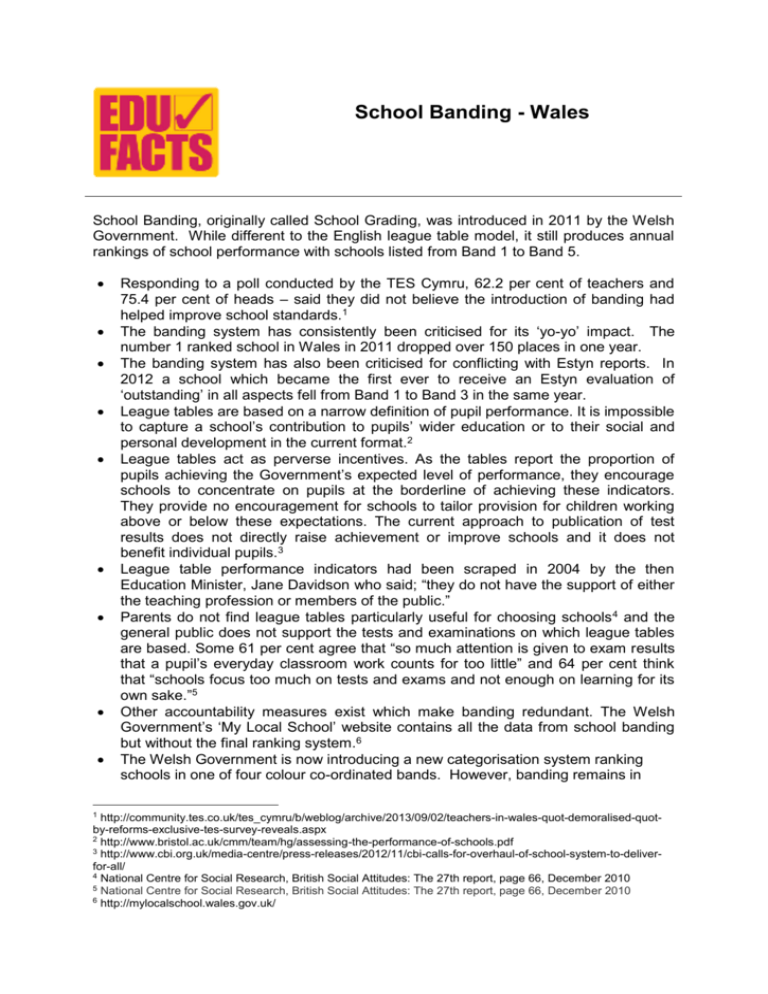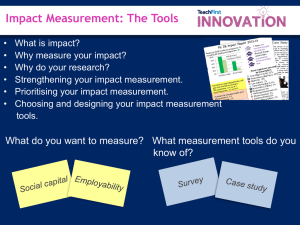School Banding - Wales School Banding, originally called School
advertisement

School Banding - Wales School Banding, originally called School Grading, was introduced in 2011 by the Welsh Government. While different to the English league table model, it still produces annual rankings of school performance with schools listed from Band 1 to Band 5. 1 Responding to a poll conducted by the TES Cymru, 62.2 per cent of teachers and 75.4 per cent of heads – said they did not believe the introduction of banding had helped improve school standards.1 The banding system has consistently been criticised for its ‘yo-yo’ impact. The number 1 ranked school in Wales in 2011 dropped over 150 places in one year. The banding system has also been criticised for conflicting with Estyn reports. In 2012 a school which became the first ever to receive an Estyn evaluation of ‘outstanding’ in all aspects fell from Band 1 to Band 3 in the same year. League tables are based on a narrow definition of pupil performance. It is impossible to capture a school’s contribution to pupils’ wider education or to their social and personal development in the current format.2 League tables act as perverse incentives. As the tables report the proportion of pupils achieving the Government’s expected level of performance, they encourage schools to concentrate on pupils at the borderline of achieving these indicators. They provide no encouragement for schools to tailor provision for children working above or below these expectations. The current approach to publication of test results does not directly raise achievement or improve schools and it does not benefit individual pupils.3 League table performance indicators had been scraped in 2004 by the then Education Minister, Jane Davidson who said; “they do not have the support of either the teaching profession or members of the public.” Parents do not find league tables particularly useful for choosing schools 4 and the general public does not support the tests and examinations on which league tables are based. Some 61 per cent agree that “so much attention is given to exam results that a pupil’s everyday classroom work counts for too little” and 64 per cent think that “schools focus too much on tests and exams and not enough on learning for its own sake.”5 Other accountability measures exist which make banding redundant. The Welsh Government’s ‘My Local School’ website contains all the data from school banding but without the final ranking system.6 The Welsh Government is now introducing a new categorisation system ranking schools in one of four colour co-ordinated bands. However, banding remains in http://community.tes.co.uk/tes_cymru/b/weblog/archive/2013/09/02/teachers-in-wales-quot-demoralised-quotby-reforms-exclusive-tes-survey-reveals.aspx 2 http://www.bristol.ac.uk/cmm/team/hg/assessing-the-performance-of-schools.pdf 3 http://www.cbi.org.uk/media-centre/press-releases/2012/11/cbi-calls-for-overhaul-of-school-system-to-deliverfor-all/ 4 National Centre for Social Research, British Social Attitudes: The 27th report, page 66, December 2010 5 National Centre for Social Research, British Social Attitudes: The 27th report, page 66, December 2010 6 http://mylocalschool.wales.gov.uk/ place. With banding, categorisation, Estyn inspections and a host of other, often contradictory accountability measures, teachers, parents and pupils are being left in limbo.










![afl_mat[1]](http://s2.studylib.net/store/data/005387843_1-8371eaaba182de7da429cb4369cd28fc-300x300.png)
